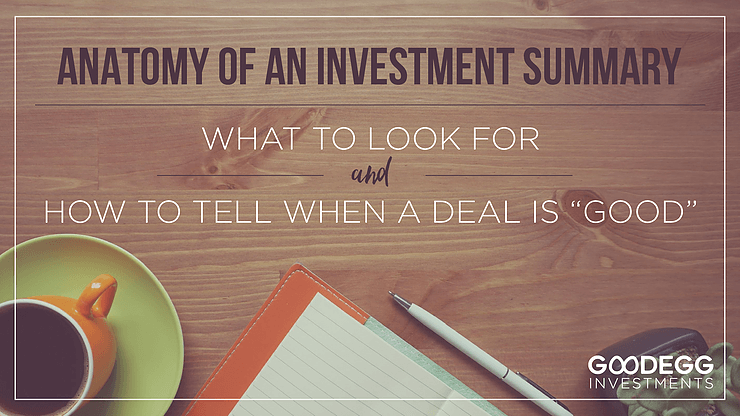Ah, investment summaries. They’re the all-in-one marketing package/business plan/underwriting explainer/photo gallery/why-you-should-invest-in-this-deal packet for every commercial real estate syndication deal that everyone loves and hates.
Often, when deal sponsors are raising money for their deals, they’ll put together investment summaries to explain to potential real estate investors why the commercial real estate deal is so great, what they plan to do with it, and how much passive income the investors stand to gain from participating in the investment.
The executive summary is a section of the confidential private offering memorandum (PPM) that quickly and as briefly as possible summarizes the real estate investment opportunity.
Real estate investment summaries are like snowflakes. No two are the same.
Some real estate investment summary documents consist of gorgeous graphics and iconography, professional photos of the real estate project, and clear tables reflecting the projected returns. Others are written like textbooks and include haphazard low-resolution phone pictures someone probably threw in at the last minute. Sigh.
But here’s the thing. Regardless of what an investment summary looks like, you have to be able to swallow your initial impressions (good or bad) and look at the numbers and business plan for what the real estate investments really are.
If you decide to invest because the investment summary looks pretty, you may be putting yourself at risk, if you haven’t done proper due diligence on the deal and the team.
Likewise, if you write off a deal because the investment summary looks like your Aunt Ida’s tax returns from last year and causes your eyes to glaze over, you might be missing out on a great opportunity.
What Should You Look For In A Real Estate Investment Summary?
It’s okay if you feel like the investment summary is some strange document in a foreign language right now because, even if you’ve owned rental properties before and have all the experience in the world finding tenants, it’s likely you’ve never seen a document such as this.
Let’s take a look at a sample investment summary. I’ll walk through my thought process when I first look through an investment opportunity, so you’ll know what to look for the next time one lands in your inbox.
Please note: For simplicity’s sake, I’m using a one-page executive summary for this example, rather than a full-blown investment summary, which could be dozens of pages long.
The Summary At A Glance For Real Estate Investors
As a real estate investor, regardless of your experience level and even though every investment summary is different, there are some basic elements that are pretty common across all multifamily real estate syndication investment summaries:
- Project name (often the name of the apartment complex)
- Photos of the rental property and area
- Overview of the submarket
- Overview of the deal
- Details of the business plan
- Projected returns and exit strategies
- Detailed numbers and analyses
- Team bios
In a one-page executive summary, you get bits and pieces of each of these elements, though you would need the full investment summary to get all the details.
If this executive summary landed in my inbox, here’s what I would do. I’d start by skimming through the whole thing.
In skimming this executive summary, here are the things that would jump out at me as a passive investor:
- Off-market
- Value-add
- Track record
- Strong submarket
- Proven model
- Equity multiple
- Unit count
Off-Market
When an asset is acquired off-market, it means that the seller chose not to list the asset publicly. Maybe the seller didn’t want the tenants to know that the building was being sold for fear of it disrupting his rental income (this is quite common). Maybe the seller needed to sell within a set timeline. Or maybe the seller already had an active real estate buyer in mind.
Regardless, off-market is almost always a good thing. This means the deal sponsor team did not have to compete with other potential buyers on price. Thus, there’s a good chance that the purchase price is low, or at least very reasonable.
Value-Add
A value-add investment is exactly what it sounds like – an asset that presents an opportunity to add value in some way. Maybe the rents are significantly below market rates because the previous owner hasn’t raised rents in 10 years. Maybe the kitchens are still from the ’90s and could use some updating. Maybe there’s an opportunity to add some more units or improve living conditions.
Whatever the case may be, value-add means more control is in the hands of the deal sponsor team. Rather than relying solely on market appreciation, there are things they can do to create additional equity, even if the real estate investing market stagnates.
One of the most common value-add scenarios is one in which the units need to be updated. Let’s say the apartments haven’t been updated in 10 years, and the rents are $1,000 per month. Even if the team were to stay the course, that $1,000 per unit would still be able to cover the mortgage and fetch a modest profit. Good deal, right?
But, who gets out of bed for modest profits? Not I.
Because there’s a chance to add value and improve the living conditions, as well as the returns for the investors, this is a true value-add. The team will go in, complete the renovations, then rent out the updated units for, say, $1,200 per month.
When you add up the $200 per month increases across all 250 units, that creates a ton of additional equity in the building, not to mention a ton of value for the residents who live there. Once residents see the updated spaces, they’re often happy to pay the higher rents and start to take more pride in their community.
Track Record
The next thing that catches my eye is, “Similar to Beta Apartments (acquired just last year and currently undergoing renovations)…” This tells me that this is not this team’s first time at the rodeo. They’ve done this before and are currently in the trenches with another asset nearby.
I also see, in the Investment Highlights section, that they’ve started implementing their business plan at Beta Apartments and that they’re surpassing their original projections. This tells me that their business plan is working and that they would likely be able to continue to strengthen their track record through Omega Apartments.
Further, this tells me that they’ve likely built up a strong reputation in the area, amongst brokers, property managers, and other apartment owners. Otherwise, they wouldn’t have been awarded this off-market deal.
Strong Submarket
I don’t know about you, but if I’m going to invest in an apartment building, I want it to be in a growing and developing area.
The fact that this submarket is the “#1 fastest growing” within this fictional metropolitan area tells me that things are moving and shaking here. I would likely open a new browser tab and immediately google that metro area and that particular submarket, to learn more about them.
What am I looking for? Things like proximity to major employers in the area, shopping centers, decent schools, population growth projections, any news about developments in the area, what it looks like on Google street view, what nearby houses are selling for, and anything else I can find.
Much of this will be in the full investment summary, but I always like to do a little of my own research on prospective investments too.
Proven Model
Did you catch it? “Ten units have already been updated and are achieving rent premiums of $150.” Jackpot.
Why is this so important? This takes all the guesswork and assumptions out of the value-add proposal. The previous owner already created the proof of concept. They updated a set amount of units, and they were able to fetch higher rents.
This is great news. This means that all we have to do is go in and continue those renovations to achieve those same rental increases. To me, this signals much lower risk in a value-add opportunity.
Equity Multiple
There are certainly lots of numbers in any investment summary, and they can be overwhelming. Percentages, splits, projected returns…what do they all mean?
One metric I’ve come to rely on is the equity multiple. In this case, the projected equity multiple is 2.1x. This means that during the life of this project, my money will be more than doubled.
That is, if you were to invest $100,000 of your hard-earned money, you would come out of this project with $210,000.
This $210,000 would include your original $100,000 investment, as well as $110,000 of profits. This $110,000 would include the quarterly cash-on-cash returns you would be getting as long as the asset is held, as well as your portion of the profits from the sale of the asset.
Typically, I look for an equity multiple around 2x, so this one passes my test.
Unit Count
I always like to know how many units I’m investing in. In this case, Omega Apartments consists of 250 units. This is a pretty decent size. This means that the team would be able to take advantage of economies of scale (i.e., increasing efficiencies by leveraging shared resources across the many units).
I will typically look at anything above 50 units. Ideally, to maximize economies of scale, I like to see over 100 units.
Next Steps To Passive Real Estate Investing
Now that I’ve taken my initial look through the executive summary, my immediate next step would be to decide whether or not to request the full investment summary.
In this case, I would go ahead and request the full investment summary, as this opportunity ticks off most, if not all, of the things I look for in a multifamily investment opportunity – strong team, strong submarket, and opportunity to add value.
In the meantime, I would do some more research on both the submarket and the deal sponsor team. I would definitely google Alpha Investments and read about the core people on their real estate investing team, learn about other investment properties in their portfolio, and see if I can find any negative reviews or stories out there about the individuals or the real estate team.
Move Quickly
Once you find a real estate investment property that meets your investment criteria, it’s critical that you move quickly. Why? Because these real estate investments fill up on a first-come, first-served basis.
Chances are, if this particular investment opportunity met your criteria, it likely met others’ syndication criteria as well. Be ready to make a soft commitment to reserve your spot, then take time to review the investment summary in detail.
Pro tip: There’s no penalty for backing out of a real estate investment down the road, so it’s to your benefit to reserve early, to ensure you get a spot in the deal. If you wait around to be 110% sure, others will have jumped in front of you in line, and you may be left on the backup list.
Request a Full Investment Summary Sample
If you’re interested in seeing a sample of a full investment summary, or to gain access to the real estate deals in our pipeline, consider signing up for the Goodegg Investor Club.
We are here to support you in your investment journey and will never pressure you to invest. Our goal is to help you gain the knowledge you need to invest with confidence (whether in our deals or not), so that together, we can change the world, one investment at a time.
Choosing Your Best Real Estate Investments
Whether active real estate investing with rental properties or passive investing with real estate syndications interests you most is going to fully depend what your personal goals are. Whether you’re attracted to office buildings or some other real estate asset class is going to depend on whether you’re investing for cash flow or appreciation as well.
There are many, many ways potential investors can get involved in investing in real estate and many ways they can find a good deal, no matter what type of property they’re after.
If you’re just getting started and interested in guidance as to which types of real estate you might pursue as your initial investment, start here.





